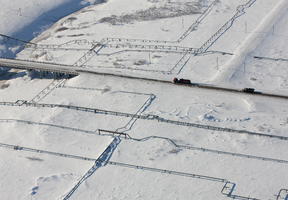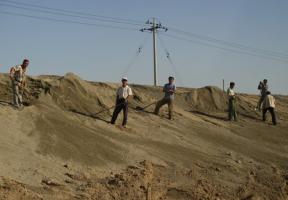Oil Sands, a Strategic and Environmental Challenge
10 min read
As conventional oil becomes increasingly scarce, have become extremely important. Extraction is, however, a complex operation that raises environmental issues. This is a major R&D challenge for oil companies.

© L.ZYLBERMAN / TotalEnergies - A sample of oil sands being analyzed.
Oil sands ˗ or bituminous sands - are a naturally occurring mixture of sand, clay, water, and extra-heavy and extremely viscous oil. In Canada, this oil is essentially immobile due to the cold climate, which is why it is called bitumen. In northern Venezuela, in the Orinoco Belt, which is 600 kilometers long, the reservoir temperature is around 50°C, meaning the same extra-heavy oil is more fluid and can be pumped. Cold production is therefore possible using fairly conventional processes.
The Athabasca oil sands in northern Alberta, Canada, are so viscous that they are immobile in the reservoir. This makes recovery more difficult, and oil companies took little interest in them until conventional oil reserves started to dwindle.
The stakes are huge: oil sands contain over 300 billion barrels of the world’s estimated proved oil resources of 1.7 trillion barrels. Canada’s oil sands reserves are equivalent to Saudi Arabia’s reserves, which alone represent about one-fifth of the world's total conventional oil reserves. And Canada has now become the main oil supplier to the United States, ahead of Saudi Arabia.
The country’s oil sands cover an area of 140,000 square kilometers, or 3% of the vast boreal forest. The deposits are located at depths of a few dozen to several hundred meters.
Two Main Recovery Methods
One of two different recovery methods is used, depending on the depth of the deposit.
Deposits nearest the surface are extracted via open-pit mining. First the ground is cleared and the topsoil set aside to be used later to reclaim the site. The area is then excavated to access the deposits and extract the sands. It takes around two tons of oil sands to produce one barrel of bitumen, which means major earthmoving work is required. Purpose-designed trucks weighing over 365 tons and as tall as three-story buildings carry out this colossal work.
For deposits deeper than 100 meters, which is the case for 80% of Canada’s oil sands, thermal methods are used. Steam is injected underground via wells to liquefy the bitumen so that it can be pumped to the surface. Known as in situ (in place)
, this method has a reduced footprint compared to mining, because only a small surface area is affected. There are two different processes:
- Cyclic Steam Stimulation (CSS) involves using the same vertical well to alternately inject steam and recover the bitumen. The steam soaks or liquefies the bitumen so that it can be pumped.
- Steam Assisted Gravity Drainage (SAGD) is based on pairs of horizontal wells. Steam is injected through the upper well to liquefy the bitumen and then the water-bitumen mixture is recovered via the lower well.
The choice of process depends on the properties of each individual deposit.
Environmental Impact
These operations and the challenging technical requirements have a major in three main areas:
- They use large amounts of water.
- They are (steam, and ) and therefore generate significant carbon emissions.
- They disrupt ecosystems by disturbing plant and wildlife.
However, studies and technical advances in recent years are improving water management, enhancing and ensuring end-of-life sites are restored to their original condition.
This is a major challenge for large oil companies, which have to make sure their operations are economically viable, while at the same time addressing and complying with strict regulations. Substantial R&D investment is essential.
Bitumen Through the Ages
Collected along the shores of the Dead Sea, bitumen was used in cosmetics and medicine by the ancient Hebrews and Sumerians. The ancient Egyptians used it to preserve mummies and caulk ships.
The world’s first oil company was created in 1741 in France to mine the oil sands in Pechelbronn, Alsace. The bitumen was used to make lamp oil, medicines, pitch and grease. The karichschmiermann - “grease salesman” - went from village to village selling it to farmers to lubricate the axles of their carts. In 1927, the company became Société des Huiles Antar (SHA).
Canada’s First Nations also collected the bitumen that oozed into the Athabasca River and used it to waterproof their canoes. In the late 18th century, Robert Fitzsimmons successfully developed a process to separate the oil from the sand and use it for roofing and paving.






















